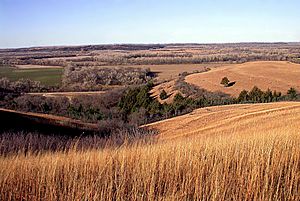Flint Hills facts for kids
The Flint Hills, also known as the Bluestem Pastures, are a special area of hills found mostly in eastern Kansas. They also stretch a bit into north-central Oklahoma. This region is one of the last large areas of tallgrass prairie left in North America. It's a unique place that looks much like it did hundreds of years ago.
Contents
What Makes the Flint Hills Special?
The Flint Hills get their name from the large amounts of flint (a type of rock) found in the soil. This flint makes the ground too rocky for plowing and farming. Because of this, the land was never turned into farms. Instead, it remained a vast grassland. This is why it's so important for nature.
Geology: Rocks and Hills
The hills were formed over millions of years. They are made up of layers of limestone and shale. These layers were created from ancient seas that once covered this area. The flint found here is very hard. It resisted erosion better than the softer rocks around it. This is why the hills stand out today.
Why Tallgrass Prairie is Important
Tallgrass prairies are ecosystems where grasses can grow very tall, sometimes over 6 feet high! They are home to many different plants and animals. Most of the original tallgrass prairie in North America has been lost. It was turned into farmland or cities. The Flint Hills are one of the biggest parts that remain. This makes them a vital place for conservation.
Life in the Flint Hills: Plants and Animals
The Flint Hills are bursting with life. They support a wide variety of plants and animals. Many of these species depend on the prairie for their survival.
Plants of the Prairie
The main plants here are tall grasses. These include big bluestem, switchgrass, and indiangrass. These grasses have deep roots. These roots help them survive dry periods. They also help prevent soil erosion. Many wildflowers also grow here. These add beautiful colors to the landscape. They also provide food for insects.
Animals of the Prairie
The Flint Hills are home to many animals. You can find bison (also called buffalo) roaming freely in some areas. They are a symbol of the American prairie. Other animals include deer, coyotes, badgers, and many types of birds. The greater prairie chicken is a special bird that lives here. Its unique mating dance is a sight to behold.
History and People of the Flint Hills
People have lived in the Flint Hills for thousands of years. Native American tribes once called this area home. They hunted bison and used the prairie's resources.
Early Inhabitants
Native American tribes like the Kansa, Osage, and Pawnee lived in the Flint Hills. They relied on the bison herds for food, clothing, and shelter. The tallgrass prairie provided everything they needed. They also used controlled fires to manage the land. This helped new grass grow.
Ranching and Conservation
When European settlers arrived, they found the land difficult to farm. The rocky soil was a challenge. However, they discovered it was excellent for raising cattle. Today, ranching is still a major activity in the Flint Hills. Ranchers use the land for grazing. They often use controlled burns. These fires help keep the prairie healthy. They also prevent trees from taking over. This practice helps maintain the tallgrass ecosystem.
Why the Flint Hills Are Important Today
The Flint Hills are more than just a pretty landscape. They play a crucial role in our environment and history.
Environmental Importance
This region acts like a giant sponge. The deep roots of the grasses help the soil absorb rainwater. This reduces flooding. It also helps keep rivers clean. The prairie also stores a lot of carbon. This helps fight climate change. It's like a natural air purifier.
Educational and Research Value
The Flint Hills are a living laboratory. Scientists study the prairie to learn about ecosystems. They research how plants and animals interact. They also learn about the effects of fire and grazing. Places like the Konza Prairie Biological Station are dedicated to this research. Students and visitors can learn about this unique environment.
The Flint Hills are a true natural treasure. They remind us of what North America once looked like. They are a vital place for wildlife and a testament to nature's resilience.
Images for kids




